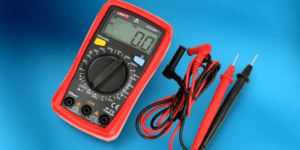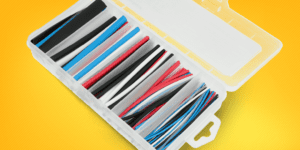There are many compatible clones of Arduino boards, but the original is only one.
This blue-coloured, credit card-sized printed circuit boards that feature 8-bit AVR microcontroller chip that is linked with input / output sockets for external devices are extremely popular among the makers, hobbyists and other DIYers. Today we discover the history of the famous open-source platform for learning programming and prototyping electronics hardware, which is called, in all its glory… Arduino. Input void setup() and let’s go!
From the beginning
Work on Arduino design started in 2003. The main assumption and goal behind this project was to create a platform for educational purposes, i.e. learning programming (software) and electronics (hardware) altogether. The first prototype was a board called Wiring designed by Hernando Barragán, a student at the Interaction Design Institute Ivrea in Italy. The target group of users were mainly students of technical schools, as well as hobbyists and makers who would like to learn programming and electronics in a practical way. All in all, not everyone wish to dive into the darkest corners of science and technology such as understanding calculus as a tool to describe the transients in semiconductor devices.

Meanwhile, across the Atlantic Ocean, Casey Reas and Benjamin Fry from Massachusetts Institute Of Technology (located in Boston, USA) are working on modifying and customizing the Processing IDE to make it compatible with the Wiring platform. Processing is an object-oriented visual programming language with an environment that allows to build applications with simple commands to make it easy to use for non-experienced in programming. This was the cornerstone for the Arduino IDE! Massimo Banzi, Hernando Barragán’s thesis supervisor, became the team leader, whose task was to make significant changes in a Wiring design. The key assumptions were to create an affordable device for programming microcontrollers, without the need to connect an external USB-ISP programmer (as is the case with regular AVR microcontrollers). The project was developed all the time – a particularly important modification was the replacement of the RS-232 connector with a USB B-type connector, which made it much easier to use.
Arduino software
Even the best car will not run without fuel, right? Those two goods are complementary. Similarly, one can say about a microcontroller – without the burned-in code, it’s just a useless piece of plastic, metal and silicon. Hence, to make it useful, you need to write a program code and upload it into the FLASH memory that is usually the internal part of a microcontroller. In case of most Arduino boards, it’s an Atmega328P – a well-known 8-bit chip used as a core of many ideas. To make the process of writing the source code much simpler, the designers of the Arduino board created the Arduino IDE – dedicated software compatible with Windows, Linux and MacOS.
Arduino IDE
The Arduino IDE interface is easy to read, and its designers also took into account novice users. The basic components of the Arduino IDE are the compiler, code editor workspace and debugging console. Thanks to this, you can quickly verify if the code sketch is correct and load and edit already created sketches. An important function of the compiler is also the code upload into the FLASH memory of the Arduino on-board MCU chip and the serial port monitor, which allows viewing the messages transferred between PC and Arduino board. In a code editor workspace, you can see another advantage of Arduino. The Arduino source code is based on C/C ++ syntax, but it is distinguished by the fact that its syntax is much more simplified and does not require knowledge of machine languages, such as very low level, very close-to-the-hardware assembler language.
We can also easily upload ready-made libraries created to support specific applications, such as, for example, distance measurement with an ultrasonic sensor, which makes prototyping via Arduino much easier. Remember, however, that Arduino is not only an educational tool, but also a very good “toy for big boys” who know low-level programming languages and the hardware architecture of microcontrollers. Thanks to the debugging console, we can thoroughly understand the mechanism of translating Arduino code into machine language, and also quickly locate potential errors in the program code if something does not work properly.
The Arduino Timeline – most important events
- 1996 – The release of AT90S8515 8-bit AVR microcontroller chip by Atmel Corporation that is designed according to a Harvard and RISC architectures – later it was used as a main chip in a Wiring board prototype.
- 2001 – The first version of Processing IDE open-source software designed by Casey Reas and Benjamin Fry is getting released.
Here is a quick shortcut, which shows how the Arduino became what is it today through the years:
- 2003 – The Wiring board prototype is getting created by Hernando Barragán. The designer staff of Interaction Design Institute Ivrea led by Massimo Banzi with David Cuartielles and David Mellis, modify Wiring to be compatible with the Atmel AVR Atmega8 chip. The first board prototype is created and named “Arduino”.
- 2005 – Start of mass production of the first official version of the Arduino board.
- 2006 – The Atmega168 is the new chip in an Arduino NG240 board, replacing the Atmega8. The FLASH memory is 16kB now – two times greater!
- 2008 – Arduino Nano and Arduino Duemilanove are released. The second one of those boards is equipped with supply voltage auto-select mode.
- 2009 – Upgrade for Arduino Duemilanove – the Atmega328 chip is getting 32kB FLASH memory.
- 2010 – Arduino Uno is getting released – as it turns out in the near future, it will be one of the most popular prototype boards in a maker community.
- 2011 – Arduino Leonardo release – the board that is based on the Atmega32U4 microcontroller. Over 300,000 original Arduino boards sold.
- 2012 – Arduino Due release – the first Arduino board featuring a 32-bit ARM MCU chip.
- 2013 – Arduino Yún is released – the board runs on a Linino OS, which is Linux based OS. Over 700 thousand original Arduino boards are sold.
- 2015 – Dispute and split in the Arduino staff due to differences in the vision of the company’s future in terms of sharing licenses with other manufacturers The Genuino brand is created, under which Arduino boards are sold out of the American market. Arduino 101 board is getting released – the board based on a 32-bit Intel Curie ARC MCU.
- 2016 – During the World Maker Faire event, Massimo Banzi (the head of Arduino LLC and Federico Musto (the head of Arduino SRL) sign a reunion agreement. New board is getting released – MKR1000 with 32-bit SAMD 21 ARM MCU chip and Wi-Fi connectivity.


Arduino as the real smash hit of hobbyists and makers communities
The Arduino is an open-source licensed project. That means, the datasheet of the Arduino, including electrical schematics is legally shared by the official manufacturer and everyone can contribute in modifying, sharing and building his own clone of the Arduino board. The popularity of Arduino boards is evidenced by several hundred thousand copies sold and a large community of users who create and share their projects on the network. Arduino users are not only hobbyists and makers, but also teachers, artists, designers and engineers.
Extensive repository of projects and libraries as well as the excellent tech support from the manufacturer and users are also important advantages that contribute to the continuous increase in popularity of these blue PCBs with AVR microcontrollers! If you want to get one – check the wide offer of a Botland Store – the official vendor of genuine Arduino boards! You can check the featured SAMD21 post and more Arduino posts on Botland blog.
How useful was this post?
Click on a star to rate it!
Average rating 0 / 5. Vote count: 0
No votes so far! Be the first to rate this post.








